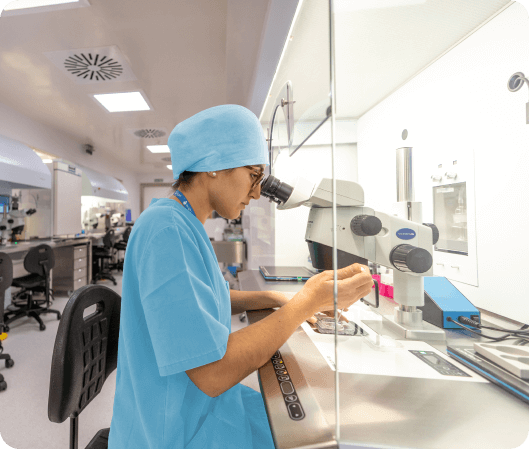Assisted reproduction options for transgender people
Today’s patterns of parenthood are evolving along with the demands of society and, whatever the case, involve the ability to reproduce and the freedom to make such a choice.
In our centres we have extensive experience and expertise in attending to LGTBIQ+ patients, regardless of their situation and needs.
Both the WHO and the World Professional Association for Transgender Health (WPATH) recognise and support the right to health care for transgender people who wish to reproduce, for whom infertility or sterility may be a consequence of hormone replacement therapies used during gender reassertion.
It is therefore of the utmost importance to inform patients who intend to undergo a gender transition process about how it may affect their fertility and the alternatives available to them in order to fulfil their expectations of present and future parenthood.

The importance of receiving information on fertility preservation for transgender people
In the case of transgender men, who receive long-term administration of testosterone (the main hormone that contributes to the development of male sexual characteristics), it should be noted that these treatments may affect ovarian reserve and reproductive possibilities.
In these situations, egg retrieval may be possible, although specialists advise fertility preservation before starting the hormonal process. However, if the patient is undergoing hormone therapy, this can be temporarily suspended before starting a fertility preservation technique, which is usually egg freezing.
In contrast, transgender men who have undergone an oophorectomy, that is, who have had their ovaries removed, would not be able to opt for any treatment with their own gametes, although there are other possibilities for them through egg donation.


How egg freezing or vitrification works
Egg freezing or oocyte vitrification is used for fertility preservation. To carry it out, the ovaries are prepared with a hormone treatment, then the oocytes are retrieved with a small puncture and subsequently frozen.
The method used is flash freezing, whereby the eggs are immersed in liquid nitrogen at -196ºC. In this way, the cells remain unchanged for an indefinite period of time, until they are used for assisted reproduction treatment.
Transgender men: What assisted reproduction treatments are available?
In order to carry out assisted reproduction treatment in trans men, it is first necessary to discontinue testosterone treatment and carry out an assessment of the ovarian reserve. If egg freezing has been used previously, these can also be used for assisted reproductive treatment.
Assuming that the partner’s sperm can be used, the options would be as follows:
- Intrauterine insemination using sperm from the partner (CAI).
- In vitro fertilisation (IVF) using your own eggs and your partner’s sperm.
In the event that recourse to a sperm donor is needed, these are the treatment options:
- Intrauterine insemination using sperm from a sperm donor (AI-D).
- In vitro fertilisation (IVF) using your own eggs and sperm from a sperm donor.
- In vitro fertilisation (IVF) using donated eggs and sperm from a sperm donor.
- The ROPA method by using the partner’s own eggs and donor sperm.
In any case, there is also the option of embryo donation.


Fertility preservation in transgender women
In the hormonal process of trans women, anti-androgen or oestrogen therapy may be used. In both situations there is a negative effect on both testicular function and sperm production and, in addition, alterations in sperm maturation and motility may occur, affecting semen quality.
Therefore, before starting the procedure, experts advise transgender women to freeze their sperm. The procedure is simple: a sperm sample is collected and frozen until the decision is made to use it. Alternatively, although this procedure is less common, testicular FNA (Fine Needle Aspiration Puncture), used to obtain sperm directly from the testicle by means of a puncture, can also be used.

Transgender women: What assisted reproduction treatments are available?
In the case of having a partner who is capable of carrying a child, there are several possibilities for assisted reproduction treatments. The first step for the trans woman would be to cease the oestrogen treatment and obtain an adequate ejaculation in order to carry out one of the following techniques in order to get her partner pregnant:
- Inseminación artificial (IAC).
- Fecundación in vitro (FIV) utilizando los óvulos de la pareja.
- Fecundación in vitro (FIV) utilizando óvulos donados.
In transgender women who have had their sperm frozen prior to treatment, this sample could be used for the same assisted reproduction procedures.
In addition, there is also the possibility of using a sperm donor or embryo donation.
More information on assisted reproductive treatments for transgender people
Contact us if you have any queries or need more information. Our multidisciplinary team of professionals will seek the best solution based on your needs.
Egg freezing treatment
Your daily routine is barely affected during the few days of the fertility preservation process.
Our article on egg vitrification process
Frozen eggs and fertility
The reproductive results of eggs frozen using the vitrification technique are comparable to those achieved with fresh eggs, according to a recent study of 1,800 people by Eugin Group researchers.
Come and visit us
We would be delighted to meet you in person, show you around our facilities and introduce you to our expert team. Visit us at:
Eugin Barcelona
C/ Balmes, 236
Phone: +34 933 221 122
Suppliers and professionals: +34 934 446 303
Eugin Madrid
C/ Alfonso XII 62, Pl. Baja A
Phone: +34 913 360 400
Suppliers and professionals: +34 934 446 303

